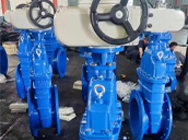slip on plate flange
The Importance of Slip-On Plate Flanges in Piping Systems
Slip-on plate flanges are crucial components in various piping systems, particularly in industries that require secure connections for transporting fluids and gases. These flanges are favored for their simplicity in design and ease of installation, making them an integral part of many engineering applications.
Design and Construction
A slip-on plate flange is characterized by its ability to slip over the pipe’s end, allowing it to be welded in place. This design typically features a flat surface for bolting to another flange, making it easy to assemble and disassemble when necessary. The material used for these flanges can vary, including stainless steel, carbon steel, or alloys, depending on the application and the types of media being transported.
One of the primary advantages of slip-on plate flanges is their compatibility with various pipe diameters. Manufacturers can produce them in a range of sizes, enabling seamless integration into existing piping systems. Additionally, the design allows for slight adjustments during installation, which can be critical in maintaining alignment, especially in complex piping layouts.
Applications
Slip-on plate flanges find applications across numerous industries, including oil and gas, petrochemical, water treatment, and power generation. In oil and gas pipelines, for instance, these flanges can connect sections of pipe with ease, ensuring a secure link that can withstand high pressures and temperatures.
In the water treatment industry, slip-on flanges are utilized to connect pipes carrying vital substances without risking leaks. The reliability of these connections is essential for maintaining the operational integrity of water treatment facilities. Power generation plants also rely on slip-on flanges for connecting turbines and boilers to the main piping network, where high-performance standards are paramount.
slip on plate flange

Advantages
The slip-on design offers several advantages compared to other types of flanges, such as welded neck or threaded flanges. First, they require less material and are consequently more cost-effective. The manufacturing process typically involves less machining, translating to lower production costs. This makes them an attractive option for large projects where budget constraints are a significant concern.
Another advantage is the simplicity of installation. Since slip-on flanges do not require precision machining for alignment, they can significantly reduce installation time and labor costs. This ease of use is especially beneficial in field installations, where conditions may not be optimal for complicated assembly processes.
Moreover, slip-on flanges can help mitigate thermal expansion issues within piping systems. As pipes expand and contract with temperature fluctuations, slip-on flanges accommodate these movements, reducing the risk of stress and damage to the piping material.
Considerations
While slip-on plate flanges offer numerous benefits, there are a few considerations to keep in mind. They may not be ideal for very high-pressure applications due to their potential for leakage at the welded joints. Proper welding techniques and best practices must be employed to ensure the integrity of these connections. Regular inspection and maintenance are also essential to prevent any issues that may arise from wear and tear over time.
Conclusion
In conclusion, slip-on plate flanges are vital components in various piping systems, providing flexibility, cost-effectiveness, and ease of installation. Their applications across multiple industries underscore their importance in facilitating secure fluid and gas transportation. By understanding the advantages and considerations associated with slip-on plate flanges, engineers and technicians can make informed decisions that enhance the efficiency and reliability of their systems. In an era where efficiency and safety are paramount, the role of such simple yet effective components cannot be underestimated. As industries continue to evolve, the demand for reliable and efficient connection solutions like slip-on plate flanges will remain a critical aspect of engineering design and application.
-
The Key to Fluid Control: Exploring the Advantages of Ball Valves in Industrial SystemsNewsJul.09,2025
-
The Versatile World of 1, 2, and 3 Piece Ball ValvesNewsJul.09,2025
-
Stainless Steel Ball Valves: The Ideal Choice for Efficient Flow ControlNewsJul.09,2025
-
Optimizing Fluid Control with Ball Float ValvesNewsJul.09,2025
-
Manual Gate Valves: Essential for Control and EfficiencyNewsJul.09,2025
-
Everything You Need to Know About Butterfly ValvesNewsJul.09,2025
-
The Versatility of Wafer Type Butterfly ValvesNewsJul.08,2025




